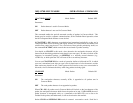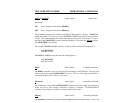
MFJ-1278B MULTI-MODE OPERATIONAL COMMANDS
DEADTIME nnn Mode: Packet Default: 33
Parameter:
nnn 0 thru 250 in 10ms.
The DEADTIME parameter selects the basic time interval used by the slotting procedures.
A delay of length = (random multiple of DEADTIME) will be applied to the all outgoing
packets that are not acknowledgmented.
DEADTIME must be set to a value that accounts for the slowest acceptable station on the
channel. It includes the time required for the remote station's radio to come on the air
properly after assertion of PTT (TXDelay) and the time required for the local station's
squelch (if used) and TNC DCD circuits to allow generation of a "DCD true" signal in the
local TNC. Ideally, once the proper value for this timer is ascertained, all stations on the
channel will use the same value.
The current default for this parameter is a short 30 milliseconds. This represents only the
worst case delay for the TNC's DCD circuit and completely ignores the radio delays.
Most HF linear mode radios are MUCH faster than VHF FM radio. A reasonable setting for
HF work is 120 milliseconds (DEAdtime set to 12). This should work fine with virtually any
HF radio stable enough to consider using on HF packet.
DELAY nn Mode: AMTOR Default: 20
The DELAY command establishes the interval, in milliseconds, that the MFJ-1278B delays
between keying the transmitter and transmitting AMTOR data.
AMTOR mode A ARQ demands a transceiver that switches from receive to transmit, and
back to receive, quickly. Some rigs are faster than others. When you install the MFJ-1278B
for the first time on a particular radio, it's a good idea to experiment with various DELAY
times, working towards the minimum delay.
Note that if you're completely unable to work anyone in MODE A, but you can work people
in modes B and S, it is possible that you are not using enough DELAY. A delay which is too
short, could result in data loss. Try increasing it until MODE A works reliably.


















